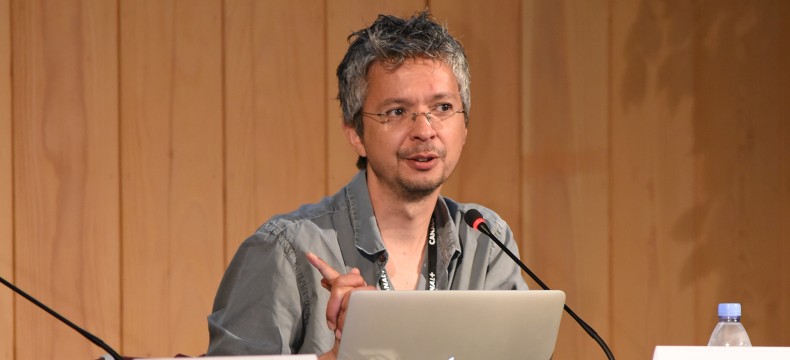2015 Conference Summaries

Pierre Coffin, Animator
Contents
Pierre Coffin is someone who knows how to convey emotion. His visual gags are intended to be simple and the characters he creates have the gift of making people laugh. His animals and creatures carry the message that with time, a lot of effort and a bit of talent, it is possible to move an audience. Here, he takes a look back over his life and career, and explains how he came to make a film with Illumination Mac Guff, a subsidiary of Paris-based Universal Studios, one of the world leaders in animated features.
Summary
Born in March 1967 to a diplomat father and writer mother, Pierre Coffin recalls his numerous trips (especially to Detroit where he learned English), and his many childhood doubts about what he was going to do with his life. Amidst all this thinking, he drew.
In a house filled with books where he was not allowed to watch television, Coffin discovered the magic of pictures, comics and French cartoonists like Sempé, whose drawings seemed so simple he was convinced he could reproduce them. "I look for simplicity because animation should easily be able to convey an idea or a joke," he says. He was also inspired by Gotlib. In 1968, the creator of Rubrique-à-brac and the Dingodossiers (with René Goscinny) was working with the magazine Pilote. His style was to take a topic, then add his own irony to it using a typically British sense of humour and a few pencil strokes. Another important reference was illustrator Gary Larson, who also uses simple drawings and nonsensical humour.
During his film studies at the Sorbonne, Pierre Coffin began drawing comical postcards. He also visited one of the first animation studios to use computers for a TV series and immediately realized that he had found his vocation. He then spent three years at the Gobelins school in Paris and followed on with a year working at Amblimation studios in London. Back in Paris, he joined Ex Machina, at the time the leading French production company for 3D computer graphics and digital special effects.
Although 3D character animation was still at the embryonic stage, Eric Darnell's film Gas Planet was a revelation to Coffin that opened up the possibilities offered by this new technology. He went on to make his first short, Pings, co-directed with Elisabeth Patte. Others followed in the same vein, along with commercials for Vichy lozenges, Vizzavi or Française des Jeux and a series of shorts: Polar Bears, for the BBC, Pat and Stan, for TF1, which were widely watched on YouTube.
With Despicable Me 1 and 2 for Universal, his Minions have now become the stars of their very own feature.
Question: Do you voice all the Minions and how did you come to create their voices?
• P.C.: It all started with Despicable Me when we decided that these characters should talk. We did some tests where their language was essentially based on invented words and discovered that it wasn’t necessarily understanding the words that made the characters comprehensible, but the melody made by their words strung together.

When Despicable Me 2 came along, the Minions took on a more important role and we had to add more words and names to their vocabulary. In general the script wasn’t very detailed and I realized I had to write something to make them talk, even if the meaning was more about the tone than the words themselves. I created more foreign words which was consistent with the storyline as at the start of the film it states that from the beginning of time the Minions have served the most diabolically bad masters from all over the world. So it makes sense that they should speak such languages as Indonesian, Chinese, Russian or Japanese.
Question: Did you already have the idea of the Minions back during the time of Pings with Elisabeth Patte?
• P.C.: No. They were supposed to just appear and disappear in Despicable Me till we realized their comic potential and decided to develop the idea. Eric Guillon first asked me if I thought it was possible to make a film of an hour and a half with characters who weren't able to speak properly. Then, once the project got underway, he worked on the artistic direction. He was right to ask this question, because actually making the film was a pretty painful process! We tried to make a series of funny gags every ten seconds but this didn't work for a feature film. So we decided to make the three characters Bob, Kevin and Stuart more individual and change the concept. Bob’s the crazy little kid, Kevin tries to bring everyone together to get things done and Stuart doesn't care about anything really!
Drafted by Alain Andrieux, ITZACOM, France
The Annecy 2015 Conference Summaries are produced with the support of:

![]()
Conferences organised by CITIA 
under the editorial direction of René Broca and Christian Jacquemart

